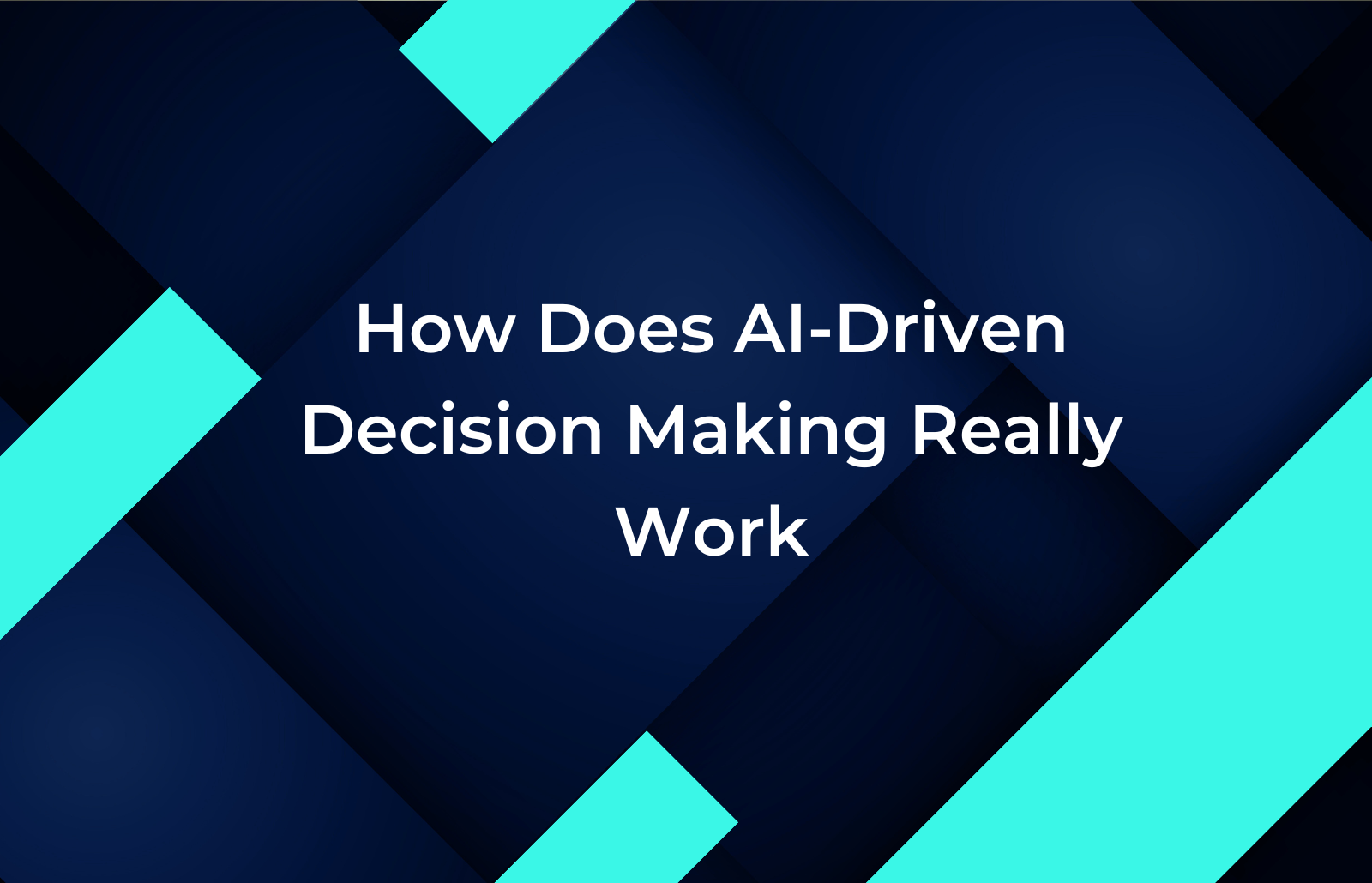Imagine a world where decisions are made not just based on gut feelings but on a deep understanding of vast amounts of data. Yes, we are talking about AI services. AI-driven decision-making is a fundamental shift in how organisations, industries, and even individuals leverage massive amounts of data for critical decisions. This is the promise of AI-driven decision-making, a powerful tool transforming how businesses operate and individuals make choices.
At its core, AI in decision-making combines data analysis and predictive modelling to improve the quality and speed of decisions. Here’s a simplified breakdown:
- Data Gathering: AI systems collect massive amounts of data from various sources, such as customer interactions, market trends, and internal operations.
- Data Analysis: Powerful algorithms sift through this data, identifying patterns, trends, and relationships that might be invisible to humans.
- Predictive Modeling: AI systems can predict future outcomes with varying degrees of certainty. For example, they can forecast sales, predict customer churn, or assess the risk of a particular decision.
- Decision Support: The AI system presents its findings to decision-makers in a clear and understandable format, often through visualisations and reports.
- Decision Making: Ultimately, humans still play a crucial role. They use AI-generated insights to inform their decisions, considering the potential risks and rewards. If you take it a step further, you could be defining the parameters for AI to make data-based decisions, so you practically offload the whole process. However, this is only advised when it comes to lower level decisions that are meant to ease your work still, such as classifying leads or customers based on where they are in their buying journey.
What Can AI Do with Data Across Different Scenarios?
The essence of AI lies in its ability to absorb, analyse, and act on data. Unlike traditional methods, AI doesn’t just crunch numbers; it learns patterns, adapts to changes, and refines its decision-making over time. Here’s a detailed look at how AI operates across diverse scenarios:
-
Data Cleaning and Organisation
Raw data is often messy and riddled with inconsistencies, duplicates, and missing information. AI tools excel at turning this chaotic input into structured, actionable insights by:
- Identifying errors automatically: AI can detect anomalies like duplicate customer records or contradictory data entries.
- Standardising formats: It converts unstructured data, like scanned PDFs or email text, into machine-readable and organised formats.
- Filling gaps intelligently: Platforms like Microsoft Azure AI can predict missing values by analysing trends across datasets.
For instance, in logistics, AI uses clean data to optimise delivery routes, significantly reducing costs and transit time.
-
Uncovering Patterns Humans Miss
AI thrives on uncovering hidden correlations in data, revealing insights humans might overlook:
- Retail: AI identifies micro-trends, such as a sudden uptick in demand for eco-friendly products, enabling proactive inventory management.
- Healthcare: Machine learning models analyse patient records against global datasets to detect early warning signs of rare diseases.
-
Predicting the Future
AI goes beyond interpreting historical data by making accurate predictions about future trends:
- Ride-sharing: Uber uses AI to forecast demand surges based on events like sports games or concerts, allowing it to adjust pricing dynamically.
- Finance: Banks deploy AI to assess credit risks, reducing non-performing loans.
This versatility allows AI to adapt its capabilities across industries like cybersecurity, advertising, and education while tailoring its applications to each context.
How Can AI Serve Data to You?
It’s one thing for AI to analyse data, but its true value lies in how it delivers actionable insights. AI simplifies and personalised complex data delivery in ways that are intuitive and user-friendly:
-
Personalised Insights for Decision-Makers
AI doesn’t overwhelm users with raw data; instead, it presents tailored recommendations to meet specific business objectives:
- Marketing: Tools like HubSpot’s AI analyse user engagement metrics to suggest content strategies that resonate with target audiences.
- Finance: Robo-advisors, such as Wealthfront, craft investment strategies by combining individual risk profiles with market forecasts.
-
Predictive Dashboards
AI-powered dashboards offer dynamic, real-time insights to empower decision-makers:
- Sales Teams: AI highlights lagging territories and suggests actionable strategies to boost performance.
- Manufacturing: AI tracks equipment performance, predicting when maintenance is needed to prevent costly downtimes.
These dashboards provide a snapshot of key metrics while allowing users to dive deeper into specific details with ease.
-
Voice and Chat Interfaces
AI integrates seamlessly with conversational platforms to provide data in an intuitive manner. For example:
- A logistics manager can ask, “What’s the real-time inventory status in Toronto?” through Google’s Dialog Flow and receive instant updates.
- Executives using Alexa for Business can query performance reports and get verbal summaries tailored to their needs.
By making insights accessible anytime and anywhere, AI eliminates delays and empowers businesses to act quickly and efficiently.
How Can You Use AI in Practice?
AI isn’t just for tech giants; it’s becoming increasingly accessible to businesses of all sizes. By integrating AI into everyday business operations, companies can make smarter, faster decisions. Here’s how you can embed AI in your decision-making processes to drive better outcomes:
-
Understand Your Goals
To make AI truly effective, it’s important to apply it to specific business challenges. AI is a powerful tool for solving problems such as:
- Reducing Customer Churn: AI can analyze customer behavior and provide insights into why people are leaving, allowing you to proactively address these issues.
- Improving Product Recommendations: AI-driven algorithms can suggest products to customers based on their preferences, leading to increased sales and customer satisfaction.
- Optimising Inventory Levels: AI can help manage stock levels by predicting demand fluctuations, which reduces waste and ensures that popular items are always available.
-
Data Preparation is Key
AI thrives on clean, organised data, so preparing your data is crucial for success. Here’s what you need to do:
- Centralise Your Data: Use tools like Snowflake, BigQuery, or similar platforms to bring together data from various sources like sales, marketing, and CRM systems into a single location.
- Ensure Privacy Compliance: Adhering to legal standards such as GDPR is critical when handling customer data. Make sure your data storage, processing, and AI models comply with privacy regulations to avoid fines and build trust with customers.
-
Leverage Low-Code AI Platforms
You don’t need a team of AI experts to take advantage of machine learning and AI solutions. Many low-code platforms offer AI tools that can be customised to suit your needs. Here are some popular options:
- Microsoft Power Platform: This allows businesses to build AI applications without needing deep technical knowledge, making it ideal for small to medium-sized companies.
- IBM Watson: With pre-built AI solutions, IBM Watson allows companies in various sectors to implement AI with minimal development effort. For example, a retailer might use Watson to automate customer support, solving a large sum of queries without human intervention.
-
Test, Monitor, and Improve
AI isn’t a “set it and forget it” solution. AI models need to be constantly tested and improved to maximise their effectiveness. Start with a small pilot project to track performance, and then make iterative changes as needed:
- Pilot Projects: Test AI applications on a smaller scale to refine them before full implementation.
- Monitor Performance: Continuously track how AI is performing in real-world situations. This could involve checking for accuracy in predictions or ensuring that automated processes are working as expected.
- Improve Models: Train AI models with new, relevant data (such as updated FAQs for chatbots) to maintain their relevance and improve accuracy over time.
What Does AI-Driven Decision-Making Look Like in Practice?
Now, let’s explore real-world examples of how businesses across various industries are using AI to drive better decision-making. From retail to healthcare, AI is transforming the way decisions are made every day:
1. Healthcare:
- Disease Diagnosis: AI algorithms analyse medical images (X-rays, MRIs) to detect abnormalities and assist doctors in diagnosing diseases like cancer or heart conditions with greater accuracy.
- Personalised Treatment Plans: AI systems analyse patient data, including medical history, genetics, and lifestyle, to recommend the most effective treatment plans tailored to individual needs.
2. Finance:
- Fraud Detection: AI algorithms monitor financial transactions in real time, identifying suspicious patterns and preventing fraudulent activities like credit card fraud or money laundering.
- Investment Strategies: AI-powered investment platforms analyse market trends, assess risk, and make automated investment decisions based on complex algorithms and real-time data.
3. Retail:
- Personalised Product Recommendations: AI systems analyse customer purchase history, browsing behavior, and preferences to recommend relevant products, enhancing the shopping experience and increasing sales.
- Inventory Management: AI algorithms optimise inventory levels by predicting demand, minimising stockouts, and reducing storage costs.
4. Customer Service:
- Chatbots: AI-powered chatbots provide instant customer support, answering frequently asked questions, resolving simple issues, and guiding customers through complex processes.
- Sentiment Analysis: AI algorithms analyse customer feedback (reviews, social media posts) to understand customer sentiment, identify areas for improvement, and enhance overall customer satisfaction.
By leveraging AI in these ways, businesses across sectors are improving efficiency, reducing costs, and making smarter, data-driven decisions. The applications of AI are limitless, and when implemented correctly, they can transform the decision-making process for the better.
Benefits of AI-Driven Decision Making
-
Increased Efficiency:
-
- Automation: Automates routine tasks, freeing up human resources for more strategic work.
- Speed: Processes information rapidly, enabling faster responses to challenges and opportunities.
-
Improved Accuracy:
-
- Data Analysis: Analyses vast datasets to identify patterns and trends humans might miss.
- Reduced Bias: This can be designed to minimise human biases, leading to fairer and more objective decisions.
-
Enhanced Decision Quality:
-
- Predictive Modeling: Forecasts future outcomes, enabling proactive planning and risk mitigation.
- Data-Driven Insights: Provides deeper understanding of complex situations, leading to more informed choices.
-
Cost Savings:
-
- Resource Optimisation: Optimises resource allocation, reducing waste, and improving efficiency.
- Reduced Errors: Minimises costly mistakes associated with human error.
-
Competitive Advantage:
-
- Innovation: Enables businesses to gain a competitive edge by making faster, better decisions.
- Customer Experience: Personalised customer experiences, leading to increased satisfaction and loyalty.
In essence, AI-driven decision-making empowers businesses and organisations to:
- Make better decisions.
- Increase efficiency and productivity.
- Gain a competitive advantage.
- Improve customer satisfaction.
- Reduce risks and costs.
By leveraging the power of AI, organisations can unlock new levels of decision-making excellence and drive significant improvements in their overall performance.
AI’s Role in Overcoming Decision-Making Challenges
Decision-making across business and other sectors presents challenges like data complexity, human biases, lack of real-time insights, and difficulties in processing vast information. AI-driven decision-making helps address these issues by transforming decision processes and enhancing outcomes. Below are key challenges and AI solutions.
-
Data Overload and Complexity
The vast amount of data businesses collect can be overwhelming, making it hard to extract relevant insights. AI can handle large datasets efficiently, identifying patterns and trends through machine learning. It simplifies data by aggregating it from various sources and presenting only the most relevant information for decision-makers.
-
Human Bias in Decision Making
Human decision-makers are often influenced by biases like confirmation bias, which can lead to poor decisions. AI removes bias by analysing data objectively. Machine learning algorithms provide rational insights based on facts, reducing subjective influences and ensuring more impartial decision-making.
-
Slow Decision-Making Process
Traditional decision-making is often slow due to manual analysis and expert consultations, especially in fast-paced environments. AI speeds up decision-making by offering real-time data analysis and immediate insights. Predictive analytics help businesses anticipate trends and make timely decisions, improving responsiveness in competitive markets.
-
Lack of Predictive Insights
Relying on historical data can hinder a business’s ability to predict future outcomes. AI’s machine learning and deep learning techniques forecast future trends with high accuracy, providing businesses with valuable predictive insights to drive proactive decisions.
-
Inconsistent Decision Quality Across Teams
In larger organisations, different teams may approach decisions in inconsistent ways, leading to inefficiencies. AI standardised decision-making by providing consistent, data-driven insights across teams, ensuring alignment, and improving overall decision quality by promoting best practices from similar industries.
-
Inability to Integrate Multiple Data Sources
Data often resides in silos, making it difficult to get a full view of the situation. AI integrates data from multiple sources, creating a comprehensive picture that supports well-rounded decision-making. It identifies relationships between disparate datasets, offering new insights and opportunities.
-
Over-reliance on Past Data
Relying too heavily on historical data can be problematic, especially in rapidly evolving markets. AI adapts to new data through continuous learning, ensuring decisions reflect the most current information. It helps businesses adjust strategies in real time based on emerging trends and sudden changes in demand.
-
Lack of Transparency in Decision-Making
Traditional decision-making processes may lack transparency, leading to confusion or distrust. AI enhances transparency by providing clear, data-backed reasons for every decision. It tracks inputs and algorithms, creating an audit trail that fosters trust and aids regulatory compliance.
Key Takeaways:
- AI-driven decision-making is not about replacing human judgment but rather augmenting it with data-driven insights and automation.
- The success of AI-driven decision-making depends on the quality of data, the sophistication of algorithms, and the appropriate level of human oversight.
- As AI technology continues to evolve, we can expect to see even more innovative applications of AI-driven decision-making across various industries.
- AI-driven decision-making transforms how businesses approach challenges and opportunities, going beyond simple task automation.
- AI helps interpret complex datasets, uncovering patterns, trends, and insights that may not be immediately visible.
- By providing actionable recommendations, AI enables faster, more informed decisions that lead to improved outcomes.
- AI processes large amounts of data quickly, significantly enhancing decision-making speed and accuracy.
- With AI, businesses can make more precise, data-driven decisions – reducing errors, and improving performance.
- AI uncovers hidden insights by analysing data from multiple sources, revealing previously inaccessible information.
- Leveraging AI helps drive business transformation, empowering smarter, more effective decision-making across operations.
The path forward lies in embracing AI as a tool and as a strategy partner, enabling smarter, faster, and more impactful decisions.
From Data to Decisions: How Zartis Empowers Businesses
At Zartis, we specialise in harnessing the power of AI to optimise decision-making processes. By integrating AI-powered tools,our specialists help organisations analyse vast datasets, identify actionable insights, and implement intelligent solutions tailored to their unique needs. Whether it’s enhancing operational efficiency, streamlining workflows, or creating predictive models, Zartis empowers companies to make informed, data-driven decisions that drive long-term success.
Access cutting-edge AI-driven platforms that are scalable, secure, and aligned with industry best practices. With a focus on collaboration and innovation, we ensure that businesses, regardless of size or sector, can effectively adopt and utilise AI to stay ahead in today’s competitive landscape.
Get in touch with our experts, who can guide you through AI adoption and help you achieve your goals. Start your AI journey today with Zartis’ consultation services!


